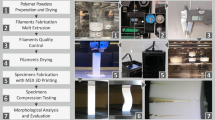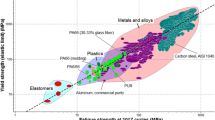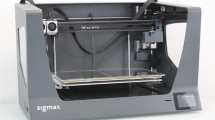Abstract
Injection molding (IM) and additive manufacturing (AM) have been widely used in the manufacturing industry because IM excels at mass production and AM allows for a great deal of design freedom. In this context, a novel hybrid manufacturing (HM) combining both has been investigated. The tensile performances of acrylonitrile butadiene styrene (ABS) and polylactic acid (PLA) specimens were studied and compared via the Taguchi method using an overprinting technique. In contrast to the extensively studied overmolding technique, we utilized AM through material extrusion to directly fabricate onto injection-molded substrates. Three parameters in this manufacturing process were studied: infill density, printing speed, and extrusion temperature. Taguchi’s L9 array, which has nine runs with three repeated specimens for each, was used to create a total of twenty-seven specimens with different processing settings in one material. All finished specimens’ dimensions were subjected to the ASTM D638-III standard. The results showed that a combination of higher infill density (75%), midprinting speed (70 mm/s), and high extrusion temperature (210 °C) was required for greater tensile strength in PLA specimens. The parameters of 75% infill density, 100 mm/s printing speed, and 220 °C extrusion temperature were required for the ABS specimens to have an exceptional tensile strength. This research provides a fundamental understanding of this promising manufacturing technology, which has the potential to produce functional items with exceptional properties such as flexural behavior, impact behavior, and certain custom-tailored features.









Similar content being viewed by others
References
Lay M, Thajudin NLN, Hamid ZAA, Rusli A, Abdullah MK, Shuib RK (2019) Comparison of physical and mechanical properties of PLA, ABS and nylon 6 fabricated using fused deposition modeling and injection molding. Compos B Eng 176(November 2018):107341. https://doi.org/10.1016/j.compositesb.2019.107341
R. Melnikova, A. Ehrmann, and K. Finsterbusch (2014) 3D printing of textile-based structures by fused deposition modelling (FDM) with different polymer materials. IOP Conf Ser Mater Sci Eng 62(1). https://doi.org/10.1088/1757-899X/62/1/012018
Stansbury JW, Idacavage MJ (2016) 3D printing with polymers: challenges among expanding options and opportunities. Dent Mater 32(1):54–64. https://doi.org/10.1016/j.dental.2015.09.018
Wang X, Jiang M, Zhou Z, Gou J, Hui D (2017) 3D printing of polymer matrix composites: a review and prospective. Compos B Eng 110:442–458. https://doi.org/10.1016/j.compositesb.2016.11.034
Gong K, Liu H, Huang C, Cao Z, Fuenmayor E, Major I (2022) Hybrid manufacturing of acrylonitrile butadiene styrene (ABS) via the combination of material extrusion additive manufacturing and injection molding. Polymers 14(23):5093. https://doi.org/10.3390/polym1423509
Fuenmayor E et al (2019) Mass-customization of oral tablets via the combination of 3D printing and injection molding. Int J Pharm 569(July):118611. https://doi.org/10.1016/j.ijpharm.2019.118611
Samykano M, Selvamani SK, Kadirgama K, Ngui WK, Kanagaraj G, Sudhakar K (2019) Mechanical property of FDM printed ABS: influence of printing parameters. Int J Adv Manuf Technol 102(9–12):2779–2796. https://doi.org/10.1007/s00170-019-03313-0
Sun Q, Rizvi G, Bellehumeur CT, Gu P (2008) Effect of processing conditions on the bonding quality of FDM polymer filaments. Rapid Prototyp J 14:72–80. https://doi.org/10.1108/13552540810862028
Hossain MS, Espalin D, Ramos J, Perez M, Wicker R (2014) Improved mechanical properties of fused deposition modeling-manufactured parts through build parameter modifications. J Manuf Sci Eng Trans ASME 136:(6). https://doi.org/10.1115/1.4028538
Wang P, Zou B, Ding S, Li L, Huang C (2020) Effects of FDM-3D printing parameters on mechanical properties and microstructure of CF/PEEK and GF/PEEK. Chinese J Aeronaut (June):1–11. https://doi.org/10.1016/j.cja.2020.05.040
Ding S, Zou B, Wang P, Ding H (2019) Effects of nozzle temperature and building orientation on mechanical properties and microstructure of PEEK and PEI printed by 3D-FDM. Polym Test 78(March):105948. https://doi.org/10.1016/j.polymertesting.2019.105948
Qamar Tanveer M, Mishra G, Mishra S, Sharma R (2022) Effect of infill pattern and infill density on mechanical behaviour of FDM 3D printed Parts- a current review. Mater Today Proc https://doi.org/10.1016/j.matpr.2022.02.310
Vaezi M, Chua CK (2011) Effects of layer thickness and binder saturation level parameters on 3D printing process. Int J Adv Manuf Technol 53(1–4):275–284. https://doi.org/10.1007/s00170-010-2821-1
Lužanin O, Movrin D, Plan M (2014) Effect of layer thickness, deposition angle, and infill on maximum flexural force in Fdm-built specimens. J Technol Plast 39(1):49–58. https://doi.org/10.1007/978-1-137-31426-0_1M4-Citavi
Abdullah Z et al (2018) The effect of layer thickness and raster angles on tensile strength and flexural strength for fused deposition modeling (FDM) parts. J Adv Manuf Technol 12(Specialissue4):147–158
Farzadi A, Solati-Hashjin M, Asadi-Eydivand M, Osman NAA (2014) Effect of layer thickness and printing orientation on mechanical properties and dimensional accuracy of 3D printed porous samples for bone tissue engineering. PLoS One 9(9):1–14. https://doi.org/10.1371/journal.pone.0108252
Chacón JM, Caminero MA, García-Plaza E, Núñez PJ (2017) Additive manufacturing of PLA structures using fused deposition modelling: effect of process parameters on mechanical properties and their optimal selection. Mater Des 124:143–157. https://doi.org/10.1016/j.matdes.2017.03.065
Wang CC, Lin TW, Hu SS (2007) Optimizing the rapid prototyping process by integrating the Taguchi method with the Gray relational analysis. Rapid Prototyp J 13(5):304–315. https://doi.org/10.1108/13552540710824814
Fernandez-Vicente M, Calle W, Ferrandiz S, Conejero A (2016) Effect of infill parameters on tensile mechanical behavior in desktop 3D printing. 3D Print Addit Manuf 3(3):183–192. https://doi.org/10.1089/3dp.2015.0036
A. Rodríguez-Panes, J. Claver, and A. M. Camacho, “The influence of manufacturing parameters on the mechanical behaviour of PLA and ABS pieces manufactured by FDM: a comparative analysis,” Materials, vol. 11, no. 8, 2018, doi: https://doi.org/10.3390/ma11081333.
Letcher T, Rankouhi B, Javadpour S (2015) Experimental study of mechanical properties of additively manufactured abs plastic as a function of layer parameters. In: ASME International Mechanical Engineering Congress and Exposition, Proceedings (IMECE), American Society of Mechanical Engineers (ASME). https://doi.org/10.1115/IMECE2015-52634
Xiaoyong S, Liangcheng C, Honglin M, Peng G, Zhanwei B, Cheng L (2017) Experimental analysis of high temperature PEEK materials on 3D printing test. Proceedings - 9th International Conference on Measuring Technology and Mechatronics Automation, ICMTMA 2017, pp. 13–16. https://doi.org/10.1109/ICMTMA.2017.0012
Nabavi-Kivi A, Ayatollahi MR, Rezaeian P, Mohammad Javad Razavi S (2021) Investigating the effect of printing speed and mode mixity on the fracture behavior of FDM-ABS specimens. Theor Appl Fract Mech 118(August 2021):103223. https://doi.org/10.1016/j.tafmec.2021.103223
Rezaeian P, Ayatollahi MR, Nabavi-Kivi A, Mohammad Javad Razavi S (2022) Effect of printing speed on tensile and fracture behavior of ABS specimens produced by fused deposition modeling. Eng Fract Mech 266. https://doi.org/10.1016/j.engfracmech.2022.108393
Kim E, Shin YJ, Ahn SH (2016) The effects of moisture and temperature on the mechanical properties of additive manufacturing components: fused deposition modeling. Rapid Prototyp J 22(6):887–894. https://doi.org/10.1108/RPJ-08-2015-0095
Wang H, Yang W, Jiao Z, Chi B, Yan H (2018) Effects of filling ratio in FDM technology on the mechanical properties of plastic products. Plastics 47(01):92–94,112, [Online]. Available: http://kns.cnki.net/kcms/detail/Detail.aspx?dbname=CJFDLAST2018&filename=SULA201801024&v=&filetitle=FDM
Zema L, Loreti G, Melocchi A, Maroni A, Gazzaniga A (2012) Injection Molding and its application to drug delivery. J Control Release 159(3):324–331. https://doi.org/10.1016/j.jconrel.2012.01.001
Campo EA (2006) Injection mold design. In: Campo EA (ed) Complete part design handbook. Hanser 545–721. https://doi.org/10.3139/9783446412927.010
Feldmann M (2016) The effects of the injection moulding temperature on the mechanical properties and morphology of polypropylene man-made cellulose fibre composites. Compos Part A Appl Sci Manuf 87:146–152. https://doi.org/10.1016/j.compositesa.2016.04.022
Dar UA, Xu YJ, Zakir SM, Saeed MU (2017) The effect of injection molding process parameters on mechanical and fracture behavior of polycarbonate polymer. J Appl Polym Sci 134(7). https://doi.org/10.1002/app.44474
Farotti E, Natalini M (2018) Injection molding. Influence of process parameters on mechanical properties of polypropylene polymer. A first study. Procedia Struct Integr 8:256–264. https://doi.org/10.1016/j.prostr.2017.12.027
Gong K et al (2022) Mass customization of polylactic acid (PLA) parts via a hybrid manufacturing process. Polymers (Basel) 14(24):5413. https://doi.org/10.3390/polym14245413
Bouwman MB, Donderwinkel T, Krämer E, Wijskamp S, Costa SF (2016) Overmolding - An integrated design approach for dimensional accuracy and strength of structural parts. Paper presented at 3rd Annual Composites and Advanced Materials Expo, CAMX 2016, Anaheim, California, United States
Arzondo LM et al (2004) Sequential injection overmolding of an elastomeric ethylene-octene copolymer on a polypropylene homopolymer core. Polym Eng Sci 44(11):2110–2116. https://doi.org/10.1002/pen.20216
Matsumoto K, Ishikawa T, Tanaka T (2019) A novel joining method by using carbon nanotube-based thermoplastic film for injection over-molding process. J Reinf Plast Compos 38(13):616–627. https://doi.org/10.1177/0731684419838070
Fu L, Zhang M, Zhai Z, Jiang F (2022) The influence of preheating temperature on the mechanical properties of injection-overmolded hybrid glass fiber reinforced thermoplastic composites. Polym Test 105:107425. https://doi.org/10.1016/j.polymertesting.2021.107425
Jerpdal L, Schuette P, Ståhlberg D, åkermo M (2020) Influence of temperature during overmolding on the tensile modulus of self-reinforced poly(ethylene terephthalate) insert. J Appl Polym Sci 137(5). https://doi.org/10.1002/app.48334.
Boros R, Tatyana A, Golcs Á, Krafcsik OH, Kovács JG (2022) Plasma treatment to improve the adhesion between ABS and PA6 in hybrid structures produced by injection overmolding. Polym Test 106. https://doi.org/10.1016/j.polymertesting.2021.107446
Boros R, Kannan Rajamani P, Kovács JG (2019) Combination of 3D printing and injection molding: overmolding and overprinting. Express Polym Lett 13(10):889–897. https://doi.org/10.3144/expresspolymlett.2019.77
Rajamani PK, Ageyeva T, Kovács JG (2021) Personalized mass production by hybridization of additive manufacturing and injection molding. Polymers (Basel) 13(2):1–19. https://doi.org/10.3390/polym13020309
Gong K, Xu H, Liu H, Cao Z, Fuenmayor E, Major I (2023) Hybrid manufacturing of mixed-material bilayer parts via injection molding and material extrusion three-dimensional printing. J Appl Polym Sci. https://doi.org/10.1002/app.53972
Xu H, Ebrahimi F, Gong K, Cao Z, Fuenmayor E, Major I (2023) Hybrid manufacturing of oral solid dosage forms via overprinting of injection-molded tablet substrates. Pharmaceutics 15(2):507. https://doi.org/10.3390/pharmaceutics15020507
Nguyen S, Perez CJ, Desimone M, Pastor JM, Tomba JP, Carella JM (2013) Adhesion control for injection overmolding of elastomeric propylene copolymers on polypropylene. Effects of block and random microstructures. Int J Adhes Adhes 46:44–55. https://doi.org/10.1016/j.ijadhadh.2013.05.016
Morales U, Esnaola A, Iragi M, Aretxabaleta L, Aurrekoetxea J (2019) Over-3D printing of continuous carbon fibre composites on organo-sheet substrates. In: AIP Conference Proceedings, American Institute of Physics Inc. https://doi.org/10.1063/1.5112520
Maier J et al (2021) Adhesion studies during generative hybridization of textile‐reinforced thermoplastic composites via additive manufacturing. Materials 14(14). https://doi.org/10.3390/ma14143888
Falck R, Goushegir SM, dos Santos JF, Amancio-Filho ST (2018) AddJoining: a novel additive manufacturing approach for layered metal-polymer hybrid structures. Mater Lett 217:211–214. https://doi.org/10.1016/j.matlet.2018.01.021
Mahmood S, Qureshi AJ, Talamona D (2018) Taguchi based process optimization for dimension and tolerance control for fused deposition modelling. Addit Manuf 21:183–190. https://doi.org/10.1016/j.addma.2018.03.009
Lee BH, Abdullah J, Khan ZA (2005) Optimization of rapid prototyping parameters for production of flexible ABS object. J Mater Process Technol 169(1):54–61. https://doi.org/10.1016/j.jmatprotec.2005.02.259
Beyer HG, Sendhoff B (2007) Robust optimization - a comprehensive survey. Comput Methods Appl Mech Eng 196(33–34):3190–3218. https://doi.org/10.1016/j.cma.2007.03.003
Alafaghani A, Qattawi A (2018) Investigating the effect of fused deposition modeling processing parameters using Taguchi design of experiment method. J Manuf Process 36(September):164–174. https://doi.org/10.1016/j.jmapro.2018.09.025
Lokesh N, Praveena BA, Reddy JS, Vasu VK, Vijaykumar S (2022) Evaluation on effect of printing process parameter through Taguchi approach on mechanical properties of 3D printed PLA specimens using FDM at constant printing temperature. Materials Today Proceedings 52(3):1288-1293. https://doi.org/10.1016/j.matpr.2021.11.054
Chen Z et al (2023) Parameter optimization for PETG/ABS bilayer tensile specimens in material extrusion 3D printing through orthogonal method. Int J Adv Manuf Technol. https://doi.org/10.1007/s00170-023-11515-w
Alzyod H, Borbas L, Ficzere P (2023) Rapid prediction and optimization of the impact of printing parameters on the residual stress of FDM-ABS parts using L27 orthogonal array design and FEA. Mater Today Proc. https://doi.org/10.1016/j.matpr.2023.02.213
Dawoud M, Taha I, Ebeid SJ (2016) Mechanical behaviour of ABS: an experimental study using FDM and injection moulding techniques. J Manuf Process 21:39–45. https://doi.org/10.1016/j.jmapro.2015.11.002
Auras RA, Harte B, Selke S, Hernandez R (2003) Mechanical, physical, and barrier properties of poly(lactide) films. J Plast Film Sheeting 19(2):123–135. https://doi.org/10.1177/8756087903039702
Datta R, Henry M (2006) Lactic acid: recent advances in products, processes and technologies a review. J Chem Technol Biotechnol 81:1119–1129. https://doi.org/10.1002/jctb.1486
Ebrahimi F, Ramezani Dana H (2021) Poly lactic acid (PLA) polymers: from properties to biomedical applications. Int J Polym Mater Polym Biomater 71(15):1117–1130. https://doi.org/10.1080/00914037.2021.1944140
Ramezani Dana H, Ebrahimi F (2022) Synthesis, properties, and applications of polylactic acid-based polymers. Polym Eng Sci 63(1):22–43. https://doi.org/10.1002/pen.26193
Tanikella NG, Wittbrodt B, Pearce JM (2017) Tensile strength of commercial polymer materials for fused filament fabrication 3D printing. Addit Manuf 15:40–47. https://doi.org/10.1016/j.addma.2017.03.005
Baich L, Manogharan G, Marie H (2015) Study of infill print design on production cost-time of 3D printed ABS parts. Int J Rapid Manuf 5(3/4):308. https://doi.org/10.1504/ijrapidm.2015.074809
Taguchi G (1990) Introduction to quality engineering. McGraw Hill Education, New York
Phillips R (1995) Taguchi techniques for quality engineering. Second, New York
Ahn SH, Montero M, Odell D, Roundy S, Wright PK (2002) Anisotropic material properties of fused deposition modeling ABS. Rapid Prototyp J 8(4):248–257. https://doi.org/10.1108/13552540210441166
Lanzotti A, Grasso M, Staiano G, Martorelli M (2015) The impact of process parameters on mechanical properties of parts fabricated in PLA with an open-source 3-D printer. Rapid Prototyp J 21(5):604–617. https://doi.org/10.1108/RPJ-09-2014-0135
Ebel E, Sinnemann T (2014) Fabrication of FDM 3D objects with ABS and PLA and determination of their mechanical properties,” RTejournal, Accessed: Jun. 28, 2022. [Online]. Available: https://www.rtejournal.de/ausgabe11/3872
Torres J, Cotelo J, Karl J, Gordon AP (2015) Mechanical property optimization of FDM PLA in shear with multiple objectives. Miner Met Materi Soci 67(5):1183–1193. https://doi.org/10.1007/s11837-015-1367-y
Alafaghani A, Qattawi A, Alrawi B, Guzman A (2017) Experimental optimization of fused deposition modelling processing parameters: a design-for-manufacturing approach. Procedia Manuf 10:791–803. https://doi.org/10.1016/j.promfg.2017.07.079
DurgaPrasada Rao V, Rajiv P, NavyaGeethika V (2019) Effect of fused deposition modelling (FDM) process parameters on tensile strength of carbon fibre PLA. Mater Today Proc 18:2012–2018. https://doi.org/10.1016/j.matpr.2019.06.009
Funding
This work was supported by the Government of Ireland International Education Scholarship from the Higher Education Authority, the COVID Support Funding from the Higher Education Authority and D/FHERIS (The Department of Further and Higher Education, Research, Innovation, and Science), and the President Doctoral Funding from Athlone Campus, Technological University of Shannon: Midland and Midwest.
Author information
Authors and Affiliations
Contributions
All authors contributed to the study conception and design. Material preparation was performed by Ke Gong, Handai Liu, Han Xu, Joseph Coyne, Zhi Cao, Evert Fuenmayor, and Ian Major; data collection was performed by Ke Gong and Ian Major; analysis was performed by Ke Gong and Ian Major. The first draft of the manuscript was written by Ke Gong and Ian Major. All authors commented on previous versions of the manuscript. All authors read and approved the final manuscript.
Corresponding author
Ethics declarations
Competing interests
The authors declare no competing interests.
Additional information
Publisher's note
Springer Nature remains neutral with regard to jurisdictional claims in published maps and institutional affiliations.
Rights and permissions
Springer Nature or its licensor (e.g. a society or other partner) holds exclusive rights to this article under a publishing agreement with the author(s) or other rightsholder(s); author self-archiving of the accepted manuscript version of this article is solely governed by the terms of such publishing agreement and applicable law.
About this article
Cite this article
Gong, K., Liu, H., Xu, H. et al. Optimizing process parameters of a material extrusion–based overprinting technique for the fabrication of tensile specimens. Int J Adv Manuf Technol 127, 3513–3524 (2023). https://doi.org/10.1007/s00170-023-11720-7
Received:
Accepted:
Published:
Issue Date:
DOI: https://doi.org/10.1007/s00170-023-11720-7




